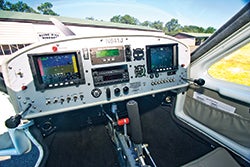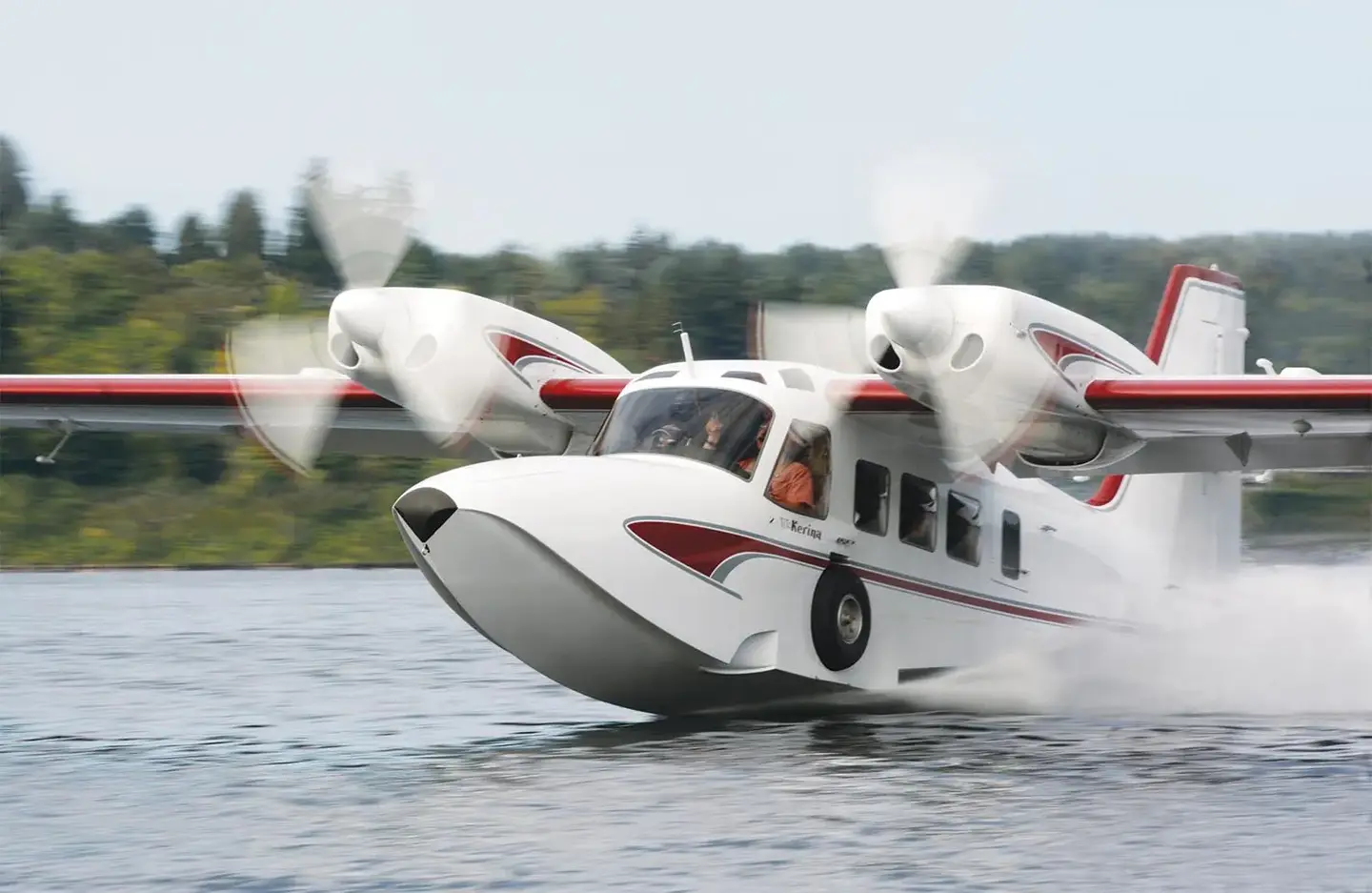Jabiru J230: Heart Of Gold
Beauty and solid, easy-flying handling in one package
 What draws a person to an airplane? For some it's raw performance---
What draws a person to an airplane? For some it's raw performance---
faster/higher/farther; for others, it's enthusiastic raves from fellow pilots. But for most of us, it's an intangible moment of "smittenness" with the sheer visual appeal of a new flying machine. How great, then, when the object of your latest affection turns out to not only have eye-catching beauty, but a heart of gold as well.
At a recent Sun 'n Fun, I hopped out of an LSA after a photo flight. Across the grassy strip of South Lakeland Airport, the streamlined-yet-robust lines of a high-winger caught my eye. "Hmm. Slick-looking ship. What is it?" I asked a nearby pilot.
 |
| The U.S.--built, Australian-designed Jabiru J230 is a high-wing airplane that's powered by a 120 hp, six-cylinder Jabiru 3300 engine. |
"One of those Aussie planes, I think," he replied. And indeed it was. Mates and Sheilas, meet the Jabiru J230-SP, a U.S.--built, Australian-designed S-LSA. A closer look revealed smooth, composite-contoured construction, three doors and a generously roomy (nearly 45-inch-wide) cockpit. The interior was lovely: optional leather seats and dual EFIS instrument panel. Center-mounted stick. Dual throttles. Electric flaps. Hydraulic brakes. An air-cooled, 120 hp, four-stroke, six-cylinder, 3,300 cc Jabiru opposed engine. And a high-aspect wing with vertical winglets. What's not to like?
First Date
Thanks to Dave Jalanti of Jabiru Power Solutions (www.jabirups.com), the Northeast Jabiru distributor, I recently took the pleasure of the J230's company at my local, upstate New York flying field, a lovely 4,000-foot grass strip known as Kline Kill. With local CFI Clifford Allen riding herd in the right seat, we taxied onto the mowed green field on a calm summer morning. Allen coached me through the takeoff: "Pull it off at about 50 knots, keep her level in ground effect until 65, then pitch for a 75-knot climb out."
 Takeoff was a breeze. Once upstairs, with no flaps and 65 knots indicated, I saw climb rates of 1,000 fpm and more, though the spec is for 700 fpm with full load. We were full-up with two 175-pound people on board and plenty of fuel ("useable" load is 520 pounds). Only five minutes into the flight, I'd answered the first question I always ask an airplane I've just met: How does it feel? It felt right. The J230 handles easily, with excellent feedback. It's smooth, easy to fly and feels...solid.
Takeoff was a breeze. Once upstairs, with no flaps and 65 knots indicated, I saw climb rates of 1,000 fpm and more, though the spec is for 700 fpm with full load. We were full-up with two 175-pound people on board and plenty of fuel ("useable" load is 520 pounds). Only five minutes into the flight, I'd answered the first question I always ask an airplane I've just met: How does it feel? It felt right. The J230 handles easily, with excellent feedback. It's smooth, easy to fly and feels...solid.
The secret to its flight personality is no secret at all. For Allen, it comes down to just two words: "dynamic stability." Allen's devoted many years to teaching people how to fly in conventional aircraft, so he knows whereof he speaks when he says, "If you displace it, what does the airplane do? If you pull back into a climb, does it seek out and return to its trimmed attitude and airspeed? That's what you'd expect to see in a Cessna. And that's what this airplane does."
He adds that he has flown several different LSA, but dynamic stability hasn't been a common trait among many of them. "It's important that, when a student is distracted, the airplane will take care of itself. Students shouldn't be able to easily stumble into uncomfortable situations, such as stalls or sudden buildups of speed." Allen considers the J230's dynamic stability as "at the level of an FAA-certificated airplane. That's what I like about it. I can fly it all day long and never work at it."
Stall? What Stall?
Eager to experience these exemplary Aussie manners for myself, I pulled the left-side, panel-mounted throttle back for a power-off stall. We had already toggled in around 16 degrees of flaps, so I eased the stick back to hold altitude. The J230 slowed and slowed, to 60 knots, then 58, then 56. "Okay," I said out loud, "I'm waiting...break whenever you want."
Allen just smiled. Slower it went, down below 50 knots at full idle, stick all the way back against the center console stop. (It's mounted just under a padded armrest, well-placed and comfortable.) Even then, the airplane wouldn't break, preferring to mush along in a slight nose-high attitude. Good on ya, mate!
I held the attitude for several more seconds as Allen pointed at the EFIS display (dual Horizon Sport flight instruments from Grand Rapids Technologies, www.grtavionics.com). "Look: Our descent rate's only 500 feet per minute." Heck, I thought, that's only eight feet per second. Parachutes bring you down faster than that (18 feet per second). Arguably, in a bad situation, you could consider riding her down with that sink rate and just 45 knots of forward speed!
 The J230 is a bit of a rudder airplane in that you need that movable tail to keep her honest at slow speeds. Rudder-pedal action is smooth and positive, with ample feedback in flight. Same on the ground, in fact, thanks to the steerable nosewheel. Keeping the J230 coordinated was easy. Like most aircraft, it likes right rudder on takeoff, but much less than some LSA I've flown. In trimmed flight, you pretty much forget about rudder except for a touchup entering and exiting turns.
The J230 is a bit of a rudder airplane in that you need that movable tail to keep her honest at slow speeds. Rudder-pedal action is smooth and positive, with ample feedback in flight. Same on the ground, in fact, thanks to the steerable nosewheel. Keeping the J230 coordinated was easy. Like most aircraft, it likes right rudder on takeoff, but much less than some LSA I've flown. In trimmed flight, you pretty much forget about rudder except for a touchup entering and exiting turns.
Back to the stall, ahem, attempt. "We flight instructors love this," said Allen as my arm was getting tired holding the stick back against the positive pitching pressure. "It's very docile."
I eased in power, and the smooth, quiet Jabiru engine cleanly accelerated us back to level flight. Allen then suggested I pull more smartly back on the stick. At last, down in the mid-40s, the nose dipped and a wing dropped, as if nodding politely.
Flaps up, power-on stalls were hardly more dramatic. The J230 got wobbly sooner without flaps, at around 58 knots indicated, and the nose angle was higher. But again, at stall, the front end just nodded and the right wing dropped slightly (my lack of rudder finesse). We relaxed the stick forward and then added a touch of power, and we were right as rain. And that's about all the news from the Dept. of Stall.
A quick note about cabin comfort: The semireclined seats cushion the body comfortably. There's lots of head and shoulder room. And even on the ground before taxiing, I had noticed a positive airflow stream from the vents beneath the panel. In flight, we had excellent air circulation---an important creature comfort on long trips.
Walkabout
Time for some cruising action. Throttling up and climbing to 2,500 feet, we leveled off and checked the numbers. At 2,850 rpm, roughly 75% power, we saw upwards of 115 knots indicated, pretty much on book. Trimming this bird is a real pleasure. Dual vertical-trim levers on either side of the lower center console are bungee-loaded. Trim adjustments are effortless and intuitive: Push forward for down, pull back for up. I much prefer this setup to trim wheels.
 |
| Pilots fly from comfortable semireclined seats in a cabin with plenty of head and shoulder room and great air circulation. |
Turns at cruise speeds reinforced that initial feeling of solid stability. The spongy stick grip feels good. The J230 isn't a fingertip-pressure airplane, though, as some LSA are. You feel the stick pressures throughout the range of movement, but control in both pitch and roll isn't stiff, just...present. Pitch pressures are lighter than roll, but it's a modest difference that doesn't require any time to get comfy with. Pitch adjustments come with a bit of finger pressure, roll takes a bit more arm-muscle input. Your arms don't get tired, but you do have to let the airplane know what you want it to do. Roll rates are consistent with a comfortable cruiser like this one, neither too fast nor too "trucky."
Control-surface feedback is much like a conventional certificated aircraft, with no surprises, no overbanking tendencies and no squirrely habits. Centering up with the rudder feels the way it should: responsive without being twitchy.
Jalanti, who covers New England giving demos in the bird, loves the Jabiru's stability and speed. "It's very comfortable for cross-country," he says. "I don't find it tiring to fly at all."
 |
| The aircraft can be equipped with dual Horizon Sport EFIS panels as an option |
Visibility in the airplane is excellent. Landings are nominal, but being as clean as it is aerodynamically (with it's high-aspect, 105-square-foot wing), the J230 needs thinking ahead to slow it down. Using 16 degrees or so of flaps and keeping approach speeds between 60 and 70 knots does the trick.
This bird likes to glide (12:1 glide ratio), so easing back on roundout and just letting her land on her own, keeping centered with rudder, does the trick.
The electric flap system has "infinite" adjustability rather than conventional detents. Actuation is through a panel-mounted toggle. A column of nine green LED lights on the panel indicates around three degrees of flaps per light, so pick your number of lights: Five, for example, gives you around 16 degrees. Max flaps is nine lights, around 30 degrees.
Aussie Pedigree
Jabiru Australia has been in the kitplane business since 1988. Jabiru USA Sport Aircraft, the American factory, receives subassembled components from Down Under and builds and test-flies the airplanes in its 11-person Shelbyville, Tenn., facility (www.usjabiru.com). The company also designs and manufactures its own line of aircraft engines, which have gained worldwide respect (in both experimental kitplanes and many production S-LSA) for smooth operation and low-cost maintenance. The J230 exceeds all ASTM-approval standards and holds full European JAR/VLA certification. Pete Krotje, Jabiru USA's president, claims the J230 passed all FAR Part 23 test parameters for strength, stability and spin recovery and is one of the most tested LSA in the world.
Unlike many LSA, the J230 has a huge storage area behind the front seats, accessible through its own large door. The space derives from the four-seat kit version. Now it's your turn to try a Jabiru J230-SP on for size; that is, if you're looking for an LSA that will treat you well during training, take you cross-country at a good clip and let you down gently. She's a corker, mates!
SPECS: Jabiru J230-SP LSA

Subscribe to Our Newsletter
Get the latest Plane & Pilot Magazine stories delivered directly to your inbox






